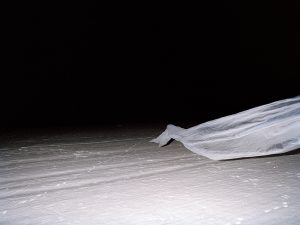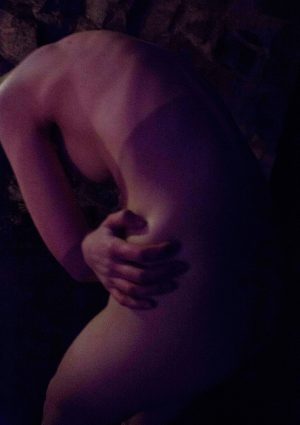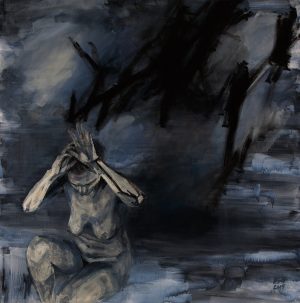Issues pertaining to gender, sexuality, and identity construction claim centre stage in 21st century Nordic literature, not least in suspense fiction. Humans as victims of their gender and past events is a recurring theme in the numerous Nordic horror stories and Gothic novels with supernatural elements published in the late 1990s and early 2000s. The Nordic authors are genre aware and norm breaking. While their works are metafictional and obviously referencing international bestsellers, there is also tendency to display a playful attitude towards genre conventions. For example, there is a frequent presence of complex female monsters, and the menacing and the monstrous is bestowed with sexual ambiguity. Thus, the Nordic authors modify the genre in order to question or change the established gender order, while concomitantly associating the Nordic landscape and regional folklore with horror.
The Gender-Coded Gothic Landscape
The Gothic authors from the turn of the Millennium are clearly situated within an established Nordic tradition, where the monster and the monstrous assume gender-transgressive and female-coded attributes due to the central role of nature. This is particularly true of the male authors and directors. Several of these works depict a move from the city and the protagonists’ unpleasant experiences in a new rural environment. In Michael Hjort’s film, Det okända (2000; The Unknown), which is in part a pastiche of the American cult film, The Blair Witch Project, five young biologists travel to the wilderness in order to study a fire-ravaged area in northern Scandinavia. In Anders Banke’s vampire film, Frostbiten (2006; Frostbite), a female physician and her daughter move to a small town to the north of the Arctic Circle. In both cases, the protagonists move to a nightmarish world where modern rationality and scientific explanations do not suffice.

Often, the horrors are associated with Nordic folktales and notions of supernatural creatures of nature. In Tommy Wiklund’s film, Vittra (2012; Wither), and Alexander L. Nordaas’ Thale (2012), the protagonists’ visit to an abandoned cabin in the woods turns into a life-and-death struggle. In both films, the horror originates from a female creature in the basement of the cabin. In Vittra, the mythical female creature of nature appears to the film’s partying youths as a bloodthirsty combination of vampire and zombie. To the two male forensic scientists in Thale, the tailed female being appears as a hybrid being, coupling human and troll. Both films are based on Nordic folklore tales of demonic female creatures of nature who challenge the protagonists’ general understanding of what constitutes the human in general and the female in particular.
The depiction of the gradual transformation of the beloved woman who finally befalls nature from the perspective of the male protagonist is a characteristic of many male authors’ and directors’ horror stories. At the end of Wiklund’s film, the male protagonist witnesses his girlfriend’s transformation into a bloodthirsty wight. Thus, in the context of modern Western horror films, the film presents a reverse gender order where the monster is not male but female, and the traditional figure of the pursued innocent female is transformed into the modern man under attack. However, unlike the ‘final girl’ in horror films, the man does not become a monster killer who internalises the monster’s attributes and methods in order to defeat it. And contrary to the female heroine, the male hero maintains his human nature. He remains, to a large extent, unaffected by ‘the other’ – the female monster.
This reversal of gender roles is also present in several literary narratives in ways, which reinforce the polarisation between male and female, between human and nature. In Kristoffer Leandoer’s (b. 1962) story, Svarta svanar (1994; Black Swans), the husband witnesses his wife’s union with the black swans breeding in the garden. In Johan Theorin’s (b. 1963) Gothic crime novel, Nattfåk (2008; The Darkest Room, 2009), the wife and children soon become part of the eerie tale about the lighthouse keeper’s home. When the wife is subsequently found drowned, she initially appears to have fallen victim to the mysterious forces and the history, which envelops the site. In both cases, the woman is not merely absorbed by nature but also by the dark history of the area.
In the novels where the male protagonist is attacked by supernatural forces, the landscape and nature are portrayed as a destructive mother goddess or Magna Mater. One of the most striking examples is Andreas Marklund’s Skördedrottningen (2007; The Harvest Queen). This novel weaves several stories and timelines together, all narrating male encounters with a lethal supernatural being in a snow-covered winterscape. All the narratives in the book describe the horror from the man’s perspective, and each and every one of his encounters with the “lady of winter” or the “woman in the tempest” leaves him in a subordinate position, as the ‘son’ or ‘child’ each and every time. The reverse gender order or power relation is also indicated by the man’s consignment to the wintry goddess of death by a closely-related woman – always a friend, family member, or colleague.

A frightening reality of nature mysticism dominated by an ancient natural force representing two aspects of nature, one life-giving and one lethal, is a recurring element in novels by female authors. In Frida Arwen Rosesund’s Förvriden (2012; Deranged) and Att de i tid må väckas (2013; That They May Be Awakened in Time), a number of young people disappear in the deep forests of northern Scandinavia. The novel recounts, from the perspective of the victims, their meeting, seduction, and violation by the folkloric creatures of nature, and their subsequent subjugation and enslavement by these creatures, subordinates of the so-called Goddess or her masculine aspect.
Förvriden describes, from the perspective of the victim, a destructive fertility ritual where young men are raped by a female monster, whose fertilization drains them of life, leaving them weak and starving to death. In Att de i tid må väckas, a male creature resembling Neck, the prehistoric evil water sprite, does indeed rape and impregnate young women. However, it is once more ultimately a female being, who represents evil and death. Both novels depict a negative matriarchy where young people are subjected to a female force of nature and a primordial force in order to spawn new life. The first novel in particular presents a reverse gender order where young men are reduced to genitals, sperm producers, and reproductive machines.
Among female authors, nature and the landscape take on a social and gender-polarised funktion, rather than a biological one. In Yrsa Sigurðardóttir’s (b. 1963) Gothic crime novels, the landscape and notions of nature mysticism constitute a central aspect of the crime and subsequent investigation. This is particularly evident in Auðnin (2008; The Day Is Dark, 2011), where a lawyer, Þóra Guðmundsdóttir, and a group of her colleagues turn up in a sparsely populated coastal area of Greenland in order to investigate the disappearance of three people in connection with the exploratory drilling of a mining company. Mysterious circumstances related to the site and its history complicate the crime investigation. Finally, it transpires that gender-related conflicts and the bullying of a homosexual man are the root causes for the disappearances. Biological sex, social expectations, and a precarious patriarchal power structure constitute an integral part of the crime and the mystery of the site.
Wild Witches in Crossover Literature
The positioning of the millennial Gothic authors within the established Nordic tradition becomes particularly clear in crossover literature – literature for young adults, particularly girls. In this genre, the Gothic castle is replaced by the Nordic wilderness and the monster represents unbridled nature. Folklore and mythical creatures of nature are accorded particular importance, while various kinds of witches and notions of witchcraft are pivotal to the plot.

The Nordic crossover stories often relate how pubescent girls develop exceptional capabilities, which carries them into a magical world. The fairy tales of the Gothic fantasy world emphasise moral conflicts and explicate the life choices the protagonist must face in order to become an adult woman. The novels depict the girls’ upbringing and transition to adulthood according to a traditional aesthetics of care, describing how the heroine must learn to take care of other living beings and live in harmony with nature. However, the stories also reassess the traditional female virtues, as it is precisely these female traits, which are prerequisites for saving the world from evil and destruction.
Mats Strandberg (b. 1976) and Sara Bergmark Elfgren’s (b. 1980) Engelsfors Trilogy – Cirkeln (2011; The Circle, 2012), Eld (2012; Fire, 2013), and Nyckeln (2013; The Key, 2015) – and Caroline L. Jensen’s (b. 1978) Vargsläkte (2011; Wolf Kindred) emphasize the value of women’s collective cooperation. In the Engelsfors Trilogy, six teenage girls discover that they have developed supernatural abilities, and have therefore been chosen to battle against the evil demons, which are taking over the woodlands surrounding the small village of Engelsfors. In Vargsläkte, Vera discovers that her grandmother and her friends are witches and that she has inherited her grandmother’s ability to assume the shape of other creatures thereby gaining access to new, powerful forces of nature. As in many other witch novels for young readers, such as Lene Kaaberbøl’s (b. 1960) Vildheks (Wild Witch) series (2010–), the good witches in the Engelsfors Trilogy and in Vargsläkte must learn to be responsible and compassionate women capable of cooperation and the suspension of their own interest for the good of others.
The presence of good and evil is a hallmark of the crossover literature where the protagonists must learn to distinguish between the two and their respective attributes. In many cases, such as Kaaberbøl’s Vildheks series and Jensen’s Vargsläkte, there is an emphasis on the guidance of older women. On the one hand, this implies that the heroine is raised to adopt traditional female virtues such as empathy, responsible cooperation, and taking an interest in the welfare of all living beings. On the other hand, the genre describes a decidedly positive matriarchal world where women are in charge and set the rules. These female coming-of-age novels thus advocate an anti-patriarchal power structure founded in ancient traditions and a strong connection to nature and the regional landscape. The genre proposes a distinct counter-vision to the individualistic lifestyles many young people are encouraged to adopt in the competitive urban societies of the new millennium.
The Gothic Romance Novel and the Monstrous
The horror is not always rooted in the uncontrollable wilderness and its creatures. Rather, many female authors situate the source of horror in the home, the family, and everyday life. Ghosts, crimes, and family secrets form a recurring constellation in the female Gothic romance novel, with well-known international predecessors such as Charlotte Brontë’s Jane Eyre (1847) and Daphne de Maurier’s Rebecca (1938). Nordic authors such as Selma Lagerlöf, Karen Blixen, and Herbjørg Wassmo join this tradition with their guilt-ridden female protagonists possessing transgressive attributes and a clear gender-political message.

Today, authors such as Majgull Axelsson (b. 1947), Olga Ravn (b. 1986), and Leonora Christina Skov (b. 1976) are writing in this Gothic tradition. Like their predecessors’ works, their stories are characterised by the complete absence of the conventional nuclear family. Rather, the protagonists are haunted by the absence of family, family history, and close biological relations. The female protagonists, what with their divided and fragmented self-images, are found lacking from the very beginning. Thus, unlike traditional horror stories, it is not a case of women’s bodies being threatened, assaulted, and transformed but rather their inner selves, their psyches, which lack a clear identity. Hence, they appear not merely with varying identities but also in various shapes and forms.
In Axelsson’s novel, Aprilhäxan (1997; April Witch, 2003), Desirée, ‘the April witch’, is both monstrous and supernatural from the very beginning. The paralysed and dying woman, in her quest for truth and vindication, moves around by taking residence in other living creatures. First, she assumes the shape of an animal in order to find and get back at her three foster sisters because her biological mother abandoned her at birth in order to care for the three ‘normal’ girls. The balance of power between Desirée and her sisters shifts, thereby also altering the Gothic romance novel’s relationship between monster and victim. While the April witch’s mission and actions do lead to revenge and devastation, her behaviour also unveils conditions that facilitate her own redemption and affords her intended victims the opportunity to admit their guilt and receive forgiveness or reconciliation.
Ravn’s Celestine (2015) presents more of an interior psychological drama. Here, the female narrator is possessed by a ghost named Celestine, who – legend has it – was immured alive in the castle after disobeying her father by refusing his choice of spouse for her. By means of poetic language and an unreliable narrative perspective, the narrator is gradually transformed into the ghost, replicating the destiny of Celestine by increasingly avoiding close relationships. Being buried assumes a new significance and the father’s punishment of Celestine is set against the emotional alienation experienced by the narrator as a child. The ghost story is thus deployed to uncover the isolation experienced by a child whose parents engage in new relationships and prioritise their new families. The story about the ghost and its link to the narrator’s family history twists the perspective, demonising contemporary life rather than the ghost story.
Skov, too, modifies the family constellations and gender themes of the Gothic genre in her metafictional novel, Silhuet af en synder (2010; Silhouette of a Sinner), which consists of multiple timelines and several female protagonists. All the women share a connection to Liljenholm Castle in South Zealand, Denmark, and its dysfunctional family tree. In the beginning of the novel, the heiress, Nella, arrives with her partner Agnes (von) Kruse(nstjerna), a wannabe author, who is documenting and writing a novel about the history of the family and the stately home. Her writing project encompasses an exploration of her own family background and the secrets surrounding her origins.
In accordance with Gothic genre conventions, the structure of Skov’s novel is complex, with stories set within the story and unreliable narrators. Initially, the novel appears to be a plot variation of the Gothic romance novel where the heroine is seemingly in peril because of the master of the castle and his secret. Eventually, however, other revelations are made and the adversary and real monster turns out to be the female mistress of the castle, a maternal figure attempting to eliminate the younger rival. Thus, the classic Gothic romance novel is presented as a territorial and power struggle between a younger and an older woman, which finally sees the younger woman emerge victorious as mistress of the castle and the man.
However, in Skov’s novel, the heterosexual gender norms and power relations of the Gothic are eliminated. The text is a postmodern variant of the Gothic romance novel, where the female heroine and narrator leaves behind the subordinate position of victimhood in her search for knowledge. Her goal is not to win a husband but to discover her family ties and construct an identity. The conflict with the older woman, the mistress of the estate, does not revolve around marrying the man or heir of the estate. Instead, the maternal figure is tasked with protecting her charge from uncomfortable truths and male oppression. In Skov’s novel, the female Gothic monster has thus been replaced with a ‘helicopter mum’ and the virgin protagonist with a goal-oriented and gender-transgressive heroine. The latter also proves herself adept in revealing and handling the truth.
Nordic Noir and Gothic Childhood Traumas
The Gothic novel’s identity theme, rich ambience, and uncertain narrators and points-of-view are also a characteristic of many Nordic crime stories, i.e. Nordic noir. While detectives and murderers in classic detective fiction are characterised by logical thinking and shrewd planning, the crimes of the new millennium are emotional acts caused by emotional trauma in the perpetrator’s past. “A childhood memory comes to me” – this is how the story of the female killer begins in Karin Fossum’s (b. 1954) Djevelen holder lyset (1998; When the Devil Holds the Candle, 2007). Capturing a criminal whose deviance is driven by childhood memories and family tragedies does not primarily require rational understanding but rather an intuitive gut feeling and the ability to place oneself in the killer’s position. Just like in the Gothic novel, the detective hero must simulate the emotional state of the criminal or the monster in order to capture and defeat the perpetrator.

In detective fiction written by female authors, crime is often linked to painful personal experiences. The link between the crime and the detective’s personal history is particularly obvious in cases investigated by a woman. Furthermore, many of the female detectives are closely connected to the site of the crime; the crime often leads the female detective back to her own past. The crime investigation thus becomes an exploration of her repressed memories. Åsa Larsson’s (b. 1966) and Camilla Läckberg’s (b. 1974) series of crime novels both begin with the return of the female detective to the site of her childhood, where she is immediately drawn into a crime investigation related to her own personal history.
The change in focus from investigation of the crime to the exploration of the detective’s personal secrets leads to a transformation of the investigation of the crime into an internal drama, which brings to mind the Gothic novel and its uncertain relationships between outer and inner reality, protagonist and monster. The depiction of the crime investigation must yield to other stories, namely those of the detective, the criminal, and the victim, and the question driving the plot is less of a ‘whodunit’ and more concerned with the murderer’s motives for doing so. This is never more so than in novels where the crime is connected to sexual abuse, gender-related violence, and childhood traumas, such as Unni Lindell’s (b. 1957) detective novel, Rødhette (2004; Little Red Riding Hood).
Violence against women and its consequences also constitute an unequivocal theme in the Nordic noir crime story par excellence – Stieg Larsson’s Millennium Trilogy about journalist Mikael Blomkvist and computer hacker Lisbeth Salander. The books – Män som hatar kvinnor (2005; The Girl with the Dragon Tattoo, 2008), Flickan som lekte med elden (2006; The Girl Who Played with Fire, 2009), and Luftslottet som sprängdes (2007; The Girl Who Kicked the Hornet’s Nest, 2010) – unmask fault lines in the democratic, Nordic welfare systems. Salander is portrayed as one part possessed Gothic heroine and two parts victim of childhood abuse and monster of the horror story whose quest for revenge sees her imbued with almost supernatural abilities. Ultimately, the Millennium Trilogy thus describes the ‘men who hate women’ and the ubiquitous forms of violence against women, which society is unable to address sufficiently.
Salander’s dual role as victim and investigator of crime, as criminal and crime buster, reinforces the moral ambiguity of the Millennium Trilogy. Protected by the anonymity of the world online, Salander fights against the patriarchy in the democratic welfare state, the family, and the world of finance by assuming multiple identities. Throughout the Millennium Trilogy, her roles as vulnerable victim, professional researcher, and relentless avenger see her strike back in response to her lost childhood. In her quest for justice, she avoids, like many other female detectives, close sexual relationships and family ties. She takes the law into her own hands in her fight for justice and gender equality, thereby acting beyond the confines of social communities and the realms of society.
Lisbeth Salander may be a damaged criminal and remorseless avenger but her struggle for justice uncovers significant shortcomings of the Nordic welfare state: political conflicts, economic corruption, abuse of power and authority, and the absence of due care and protection of children by the social services. The childhood violations experienced by Salander, within her family as well as the public welfare system, fuel her desire for revenge. Furthermore, her personal story reveals the hidden gender structures, the sexual vulnerability of women in all social relations, and the democratic state’s inability to resolve this. In order to achieve justice by putting an end to the men who hate women, women must resort to unconventional methods and physical violence.
In the Millennium Trilogy, the story, which frames fictional events and characters with actual characters and stories from real life, unfolds in tandem with the discourse on gender politics. The novels continuously refer to well-known detective stories by writers such as Dorothy L. Sayers, Agatha Christie, and Elisabeth George, as well as spy novels and male action heroes such as James Bond, Superman, and Batman. From the very beginning, there are even more direct associations with the universe of Astrid Lindgren’s (1907-2002) children’s books. In the first chapter, Mikael Blomkvist is called Kalle Blomkvist, the original Swedish name of Lindgren’s kid detective, Bill Bergson. Similarly, the reader is frequently reminded of the similarity between Lisbeth Salander and Lindgren’s girl heroine, Pippi Longstocking, thus reinforcing Salander’s non-human and fictional powers as a super heroine. She increasingly appears as a monstrous adult version of Pippi.
This gradual alienation of Salander clearly places her in the Gothic genre. Her theatrical appearance, dark punk style, amoral behaviour, and superhuman attributes reference the notion of the Gothic monster. Like the monster, she is a fusion of ordinarily incompatible attributes. Her body is lithe and girlish yet she is also portrayed as a skilled boxer. She is socially inept, displays autistic traits, but is remarkably skilled at predicting the reactions of other people. She enacts the post-structuralist concept of gender and identity as continuous performance and dissimulation. At the same time, she is – like the monster in horror stories – driven by self-interest and her assiduous fighting spirit is quite notable. After being seemingly dead and buried by her enemies, her own father and half-brother, she is resurrected from the grave, like Stephen King’s girl monster in Carrie, in order to resume her mission of revenge and her fight for justice.
The Transgressive Female Monsters of the New Millennium
The female detectives, Gothic heroines, and monsters of the new millennium are transgressive creatures, whether portrayed, like Lisbeth Salander, as playful metafictional creations referencing other fictional super heroines or depicted as mythical creatures from Nordic folklore like Axelsson’s April witch. The association of the female protagonist with the physical landscape and nature in crossover literature and the Gothic novel imbues her with superhuman attributes, enabling her to transgress social conventions and physical boundaries. While the female protagonist is transformed into a destructive female monster in the works of many male authors, the works of female authors often establishes an association between the female protagonist and the local landscape and history, which proves pivotal for her understanding of self and her future life.
The development of the female protagonist’s personal liberation in crossover literature, the postmodern Gothic novel, and detective fiction is not merely concerned with self-realisation and identity construction; more than anything, it enables her to create room for manoeuvre in order to deal successfully with gender-based limitations and oppression. To this end, a strikingly large number of millennial monster heroines have to uncover secrets and do away with their origins and family history, not merely to achieve professional success but in order to create a future beyond the limitations of the dominant gender contract and traditional family constellations.
Fiction
- Majgull Axelsson: Aprilhäxan. Raben Prisma, 1997. April Witch, Villard, 2003
- Anders Banke: Frostbiten (film). Paramount Pictures, 2006
- Karin Fossum: Djevelen holder lyset. Cappelens Forlag, 1998. When the Devil Holds the Candle, Mariner Books, 2007
- Michael Hjorth: Det okända (film). Tre Vänner AB, 2000
- Caroline L. Jensen: Vargsläkte. Ord Text Mening, 2011
- Lene Kaaberbøl: Vildheks. Alvilda, 2010-
- Stieg Larsson: Män som hatar kvinnor. Norstedt, 2005. The Girl with the Dragon Tattoo, Knopf, 2008
- Stieg Larsson: Flickan som lekte med elden. Norstedt, 2006. The Girl Who Payed with Fire, Knopf, 2009
- Stieg Larsson: Luftslottet som sprängdes. Norstedt, 2007. The Girl Who Kicked the Hornet’s Nest, Knopf, 2010
- Kristoffer Leandoer: Svarta svanar. Norstedt, 1994
- Unni Lindell: Rødhette. Aschehoug, 2004.
- Andreas Marklund: Skördedrottningen. Järnringen, 2007
- Aleksander L. Nordaas: Thale (film). Film Fund FUZZ, 2012
- Olga Ravn: Celestine. Gyldendal, 2015
- Frida Arwen Rosesund: Förvriden. Mörkersdottir, 2012
- Frida Arwen Rosesund: Att de i tid må väckas. Mörkersdottir, 2013
- Yrsa Sigurðardóttir: Auðnin. Forlag id, 2008. The Day is Dark, Hodder & Stoughton, 2011
- Leonora Christine Skov: Silhuet af en synder. Rosinante, 2010
- Mats Strandberg og Sara Bergmark: Cirkeln. Rabén & Sjögren, 2011. The Circle, Hammer, 2012
- Mats Strandberg og Sara Bergmark: Eld. Rabén & Sjögren, 2012. Fire, Hammer, 2013
- Mats Strandberg og Sara Bergmark: Nyckeln. Rabén & Sjögren, 2013. The Key, Hammer, 2015
- Johan Theorin: Nattfåk. Wahlström & Widstrand, 2008. The Darkest Room, Doubleday, 2009
- Tommy Wiklund: Vittra (film). Studio S Entertainment, 2012
Non-Fiction
- Kristine Kastbjerg: ”Reading the Surface: The Danish Gothic of B. S. Ingemann, H. C. Andersen, Karen Blixen and Beyond”. Scandinavian Studies 3, 2013
- Yvonne Leffler: ”Lisbeth Salander as a Melodramatic Heroine: Emotional Conflicts, split Focalization, and Changing Roles in Scandinavian Crime Fiction”. Rape in Stieg Larsson’s Millennium Trilogy and Beyond, B. Åström, K. Gregersdotter og T. Horeck (red.). Palgrave Macmillan, 2013
- Yvonne Leffler: ”The Devious Landscape in Contemporary Scandinavian Horror”. Gothic Topographies: Language, Nation Building and Race, P.M. Mehtonen og Matti Savolainen (red.). Routledge, 2013
- Diana Wallace & Andy Smith (red.): The Female Gothic: New Directions. Palgrave Macmillan, 2009


